#Mutants vs. Ultras: First Encounters
Explore tagged Tumblr posts
Text
Mutants vs. Ultras: First Encounters #1 (1995) Jeff Matsuda Wrap-Around Cover, Len Strazewski, Gerard Jones, Steve Englehart & Peter David Writers, Kyle Hotz, John Statema & Kevin West Pencils, 1st Appearance of Dr. Eugene Wildeman & Wildeman Monsters
#MutantsvsUltrasFirstEncounters #1 (1995) #JeffMatsuda Wrap-Around Cover, #LenStrazewski, #GerardJones, #SteveEnglehart & #PeterDavid Writers, #KyleHotz, #JohnStatema & #KevinWest Pencils, 1st Appearance of #DrEugeneWildeman & Wildeman Monsters "Monsters of Manhattan" https://rarecomicbooks.fashionablewebs.com/Mutants%20vs%20Ultras%20First%20Encounters.html#1 @rarecomicbooks Website Link In Bio Page If Applicable. SAVE ON SHIPPING COST - NOW AVAILABLE FOR LOCAL PICK UP IN DELTONA, FLORIDA #MalibuComics #RareComicBooks #KeyComicBooks #MCU #MarvelComics #MarvelUniverse #KeyComic #ComicBooks


#Mutants vs. Ultras: First Encounters#1 (1995) Jeff Matsuda Wrap-Around Cover#Len Strazewski#Gerard Jones#Steve Englehart & Peter David Writers#Kyle Hotz#John Statema & Kevin West Pencils#1st Appearance of Dr. Eugene Wildeman & Wildeman Monsters#Rare Comic Books#Key Comic Books#DC Comics#DCU#DC#Marvel Comics#MCU#Marvel#Marvel Universe#DC Universe#Dynamite Entertainment#Dark Horse Comic Books#Boom#IDW Publishing#Image Comics#Now Comics
0 notes
Photo

MUTANTS VS ULTRAS: FIRST ENCOUNTERS (part 2, 1995) / SHEDDING SKIN (part 2, 1995) Turns out the reason Wolverine's so short is he's had his neck removed... MORE: bit.ly/MutantsVsUltras-Part2 --- Artists: Kyle Hotz & Jimmy Palmiotti Colours: Mickey Rose Script: Steve Englehart From: Night Man vs Wolverine 0 (interior) Featuring: Wolverine (of Earth-616) vs NightMan of (Earth-93060) --- NEW UPDATE: Another Ultra finds himself in the Marvel Universe when Night Man gets transported across realties by Rhiannon. Marvel made a bit of a half-hearted effort to integrate the Ultraverse characters into the Marvel Universe. Ultimately, this made the original Ultraverse fans unhappy and didn't appeal to enough of the hardcore Marvel fans. The Ultraverse wouldn't be long for this world...
#Kyle Hotz#Jimmy Palmiotti#Steve Engelhart#Night Man vs Wolverine#Night Man#Wolverine#Earth-616#Earth-93060#Mutants vs Ultras First Encounters#Mutants vs Ultras#Shedding Skin#Logan#Marvel#X-Men#Ultraverse#Malibu Comics#marvel comics#marvel universe
16 notes
·
View notes
Photo

PHANNIEMAY 2018: Shades of the Universe Trap card(Crossover)
"Well,well,well...looks like we have a handsome mutant girl from an anime,a space-loving undead cartoon and the great Super Mario just came to the World of mercenaries by helping Mann Co get some alien monster pelt that I can expose in my office!”
Here’s the first mission of the future Multiversal team called REDNESS TEAM
Next Time on PhannieMay Season 2:Shin Sekai Kokyogaku(Stars)
Click to read more to see the full list of my entries
D1-Electric Boogaloo(Electricity)
D2-Green is not a creative color(Green)
D3-You done fucked up,tin can(DNA / Ghost Tech)
D4-For fuck’s sake,an Eclipse doesn’t mean apocalypse(Eclipse)
D5-Phantom,why do you have to be a jackass to that ghost?(10 Years Later)
D6-Welcome to Nilfheim(World-building)
D7-Ultra Core Overload(Core / Limitless)
D8-Sleep tight(Clones)
D9-Chernobog VS Geb!(Power Surge)
D10-TRAP CARD:Shades of the Universe(Crossover)
D11-Shin Sekai Kokyogaku(Stars)
D12-This time shall be DIFFERENT!(Callback / Villains)
D13-Good-kinded Pharaon(Swap/Hide and Seek)
D14-Blumenkranz(Flowers)
D15-Swiggitty Swotty! Comin for da booty(Girls)
D16-Box Ghost,stalker extraordinaire(Gift)
D17-Ghosts & Goblins(Royalty)
D18-TRAP CARD: Cold Hands(Revive / Different Decade)
D19-First encounter(Phandom)
D20-Nightmareception(Nightmare)
D21-What will Wulf do?(Battle)
D22-Hipster!Sam(Vintage)
D23-???(Wardrobe)
D24-???(Alternate Universe / Paparazzi)
D25-???(Cold)
D26-???(Imprisoned)
D27-???(Exposed)
D28-???(Role Playing / Animals)
D29-???(Season Four)
D30-???(Together)
D31-???(Free Day)
#phanniemay#phanniemay18#Danny Phantom#super smash bros#kill la kill#saxton hale#SotuSHADES OFTHEUNIVERSES#time for some good ol' crossover#myart
13 notes
·
View notes
Text
New Post has been published on GoingFullNerd
New Post has been published on http://goingfullnerd.com/justice-society-world-war-ii/
JUSTICE SOCIETY: WORLD WAR II

COMING TO DIGITAL APRIL 27, 2021 & 4K ULTRA HD™ BLU-RAY COMBO PACK & BLU-RAY™ ON MAY 11, 2021 STANA KATIC, MATT BOMER RETURN IN NEW ROLES FOR FIRST JUSTICE SOCIETY OF AMERICA STORY IN POPULAR DC UNIVERSE MOVIES SERIES
youtube
STANA KATIC, MATT BOMER RETURN IN NEW ROLES FOR FIRST JUSTICE SOCIETY of AMERICA STORY IN POPULAR DC UNIVERSE MOVIES SERIES
BURBANK, CA (February 4, 2020) – The Flash speeds into the middle of an epic battle between Golden Age DC Super Heroes and Nazis in Justice Society: World War II, the next entry in the popular series of the DC Universe Movies. Produced by Warner Bros. Animation, DC and Warner Bros. Home Entertainment, the feature-length animated film will be released on Digital starting April 27, 2021, and on 4K Ultra HD Blu-ray Combo Pack and Blu-ray on May 11, 2021. The film is rated PG-13 for violence and some bloody images.
Justice Society: World War II will be available on 4K Ultra HD Blu-ray Combo Pack (USA $39.99 SRP; Canada $44.98 SRP) and Blu-ray (USA $29.98 SRP; Canada $39.99 SRP) as well as on Digital. The 4K Ultra HD Blu-ray Combo Pack features an Ultra HD Blu-ray disc in 4K with HDR, a Blu-ray disc featuring the film in hi-definition, and a digital version of the movie. The Blu-ray features a Blu-ray disc with the film in hi-definition and a digital version of the movie.
Justice Society: World War II finds modern-day Barry Allen – prior to the formation of the Justice League – discovering he can run even faster than he imagined, and that milestone results in his first encounter with the Speed Force. The Flash is promptly launched into the midst of a raging battle – primarily between Nazis and a team of Golden Age DC Super Heroes known as The Justice Society of America. Led by Wonder Woman, the group includes Hourman, Black Canary, Hawkman, Steve Trevor and the Golden Age Flash, Jay Garrick. The Flash quickly volunteers to assist his fellow heroes in tipping the scales of war in their favor, while the team tries to figure out how to send him home. But it won’t be easy as complications and emotions run deep in this time-skipping World War II thriller.
Stana Katic (Castle, Absentia, A Call To Spy) and Matt Bomer (Doom Patrol, White Collar, The Boys in the Band), who made their DC Universe Movies debuts as Lois Lane and Superman in the 2013 film Superman: Unbound, return to the popular animated film series in the lead roles of Wonder Woman and The Flash for Justice Society: World War II. The star-studded cast includes Geoffrey Arend (Madam Secretary, Batman: Hush) as Charles Halstead/Advisor, Armen Taylor (JoJo’s Bizarre Adventure: Golden Wind) as Jay Garrick, Elysia Rotaru (Arrow) as Black Canary, Liam McIntyre (The Flash, Spartacus, Justice League Dark: Apokolips War) as Aquaman, Omid Abtahi (American Gods, The Mandalorian) as Hawkman, Matthew Mercer (Critical Role, Overwatch) as Hourman, Keith Ferguson (Foster’s Home for Imaginary Friends, Overwatch) as Dr. Fate, Darin De Paul (Overwatch, Mortal Kombat Legends: Scorpion’s Revenge) as Franklin Delano Roosevelt, Ashleigh LaThrop (The Handmaid’s Tale, Utopia, The Kominsky Method) as Iris West, and Chris Diamantopoulos (Episodes, Silicon Valley, voice of Mickey Mouse) as Steve Trevor.
Jeff Wamester (Guardians of the Galaxy TV series) directs Justice Society: World War II from a screenplay by Meghan Fitzmartin (Supernatural, DC Super Hero Girls) and Jeremy Adams (Supernatural, Batman: Soul Of The Dragon). Producers are Jim Krieg (Batman: Gotham by Gaslight) and Kimberly S. Moreau (Batman vs. Teenage Mutant Ninja Turtles). Butch Lukic (Superman: Man of Tomorrow, Constantine: City of Demons) is Supervising Producer. Sam Register is Executive Producer.
Justice Society: World War II Special Features
4K Ultra HD Blu-ray Combo Pack, Blu-ray and Digital
DC Showcase – Kamandi: The Last Boy on Earth! (New Animated Short) – Jack Kirby’s beloved DC comic creation features the last civilized teenage boy on a post-apocalyptic Earth ruled by talking animals. In this short, Kamandi and his friends Prince Tuftan of the Tiger Kingdom and humanoid mutant Ben Boxer are kidnapped by a gorilla cult dedicated to finding the reincarnation of their god, The Mighty One. Golgan, the cult’s leader, puts Kamandi’s team through a series of deadly tests to find if any of them know the secret of … The Mighty One.
Adventures in Storytelling: Justice Society: World War II (New Featurette) – The film’s creative minds chat about the methods used to produce the touchstone sequences in Justice Society: World War II.
A Sneak Peek at the next DC Universe Movie – An advance look at the next animated film in the popular DC Universe Movies collection, Batman: The Long Halloween, Part One.
Look Back – Justice League vs. Teen Titans (Featurette) – A behind-the-scenes look at the making of Justice League vs. Teen Titans, a 2016 thriller that follows Damian Wayne’s induction into the Teen Titans. Complicating his training is the growing presence of Raven’s satanic, world-conquering father Trigon, whose escape plan from his inter-dimensional prison includes spreading his demonic forces across the globe, infiltrating the minds and bodies of the Justice League to do his bidding. To save the universe and prevent a literal hell on Earth, the Teen Titans must rescue – or defeat – the Justice League, and intern Trigon for all eternity.
Look Back – Wonder Woman: Bloodlines (Featurette) – An intriguing glance into the production behind 2019’s Wonder Woman: Bloodlines, which finds Amazon Princess Diana helping a troubled young girl enlisted by a deadly organization known as Villainy, Inc., whose criminal members have their sights set on invading Themyscira. The expansive adventure is packed with brutal battles, mysterious mythology, and endless wonder!
From the DC Vault: Justice League: “Legends, Part One”
From the DC Vault: Justice League: “Legends, Part Two”
Justice Society: World War II will also be available on Movies Anywhere. Using the free Movies Anywhere app and website, consumers can access all their eligible movies by connecting their Movies Anywhere account with their participating digital retailer accounts.
DIGITAL DISTRIBUTION ELEMENTS
On April 27, 2021, Justice Society: World War II will be available to own in high definition and standard definition from select digital retailers including Amazon, the Apple TV app, FandangoNOW, PlayStation, Vudu, Xbox and others. On May 11, 2021, Justice Society: World War II will be made available digitally on Video On Demand services from cable and satellite providers, and on select gaming consoles.
ABOUT MOVIES ANYWHERE
Movies Anywhere is a digital movie platform that enables movie fans to discover, access, and watch their favorite digital movies in one place. Movies Anywhere brings together a library of nearly 7,500 digital movies from Sony Pictures, Twentieth Century Fox Film, The Walt Disney Studios (including Disney, Pixar, Marvel Studios and Lucasfilm), Universal Pictures (including DreamWorks and Illumination Entertainment) and Warner Bros., and will continue to expand the consumer experience as more content providers, digital retailers and platforms are added. By connecting participating digital retailers that include Amazon Prime Video, the Apple TV app, FandangoNOW, Google Play, and Vudu, movie fans can now bring together their digital movie collections (whether purchased or redeemed) in one place and enjoy them from the comfort of their living rooms, and across multiple devices and platforms, including Amazon Fire devices; Android devices and Android TV; Apple TV, iPhone, iPad and iPod touch; Chromecast; Roku® devices and popular browsers. Movie fans can also redeem digital codes found in eligible Blu-ray and DVD disc packages from participating studios and enjoy them through Movies Anywhere. Movies Anywhere – your movies, together at last.
ABOUT DIGITAL
Digital movies or TV episodes allow fans to watch a digital version of their movie or TV show anywhere, on their favorite devices. Digital movies or TV episodes are included with the purchase of specially marked Blu-ray discs. With digital, consumers are able to instantly stream and download movies and TV shows to TVs, computers, tablets and smartphones through retail services. For more information on compatible devices and services go to wb.com/digitalmoviefaq. Consult a digital retailer for details and requirements and for a list of digital-compatible devices.
BASICS
PRODUCT SRP
4K UHD Blu-ray Combo Pack $39.99 USA, $44.98 Canada
Blu-ray $29.98 USA, $39.99 Canada
Blu-ray Languages: English, Spanish, French, German
Blu-ray Subtitles: English, Spanish, French, German, Swedish, Danish, Finnish, Norwegian
4K Blu-ray Languages: English, Spanish
4K Blu-ray Subtitles: English, French
Running Time: 84 minutes
Rated PG-13
About Warner Bros. Home Entertainment, Inc.:
Warner Bros. Home Entertainment (WBHE) brings together Warner Bros. Entertainment’s physical and digital distribution businesses in order to maximize current and next-generation distribution scenarios. An industry leader since its inception, WBHE oversees the global distribution of content through packaged goods (Blu-ray Disc™ and DVD) and digital media in the form of electronic sell-through and video-on-demand via cable, satellite, online and mobile channels. WBHE distributes its product through third party retail partners and licensees.
ABOUT DC
DC, a WarnerMedia Company, creates iconic characters, enduring stories, and immersive experiences that inspire and entertain audiences of every generation around the world and is one of the world’s largest publishers of comics and graphic novels. As a creative division, DC is charged with strategically integrating its stories and characters across film, television, consumer products, home entertainment, interactive games, DC UNIVERSE INFINITE digital subscription service and community engagement portal. For more information visit dccomics.com and dcuniverseinfinite.com.
JUSTICE SOCIETY: WORLD WAR II © 2021 Warner Bros. Entertainment Inc. JUSTICE SOCIETY and all related characters and elements are trademarks of and © DC Comics.
About Warner Bros. Animation
Warner Bros. Animation (WBA) is one of the leading producers of animation in the entertainment industry, producing and developing projects for multiple platforms, both domestically and internationally. WBA’s current series include Animaniacs for Hulu, Green Eggs and Ham for Netflix, Aquaman: King of Atlantis, Batwheels, Gremlins: Secrets of the Mogwai, Harley Quinn, Jellystone!, Little Ellen, Looney Tunes Cartoons, Tiny Toons Looniversity and Young Justice for HBO Max, DC Super Hero Girls, Teen Titans Go!, ThunderCats Roar for Cartoon Network, Dorothy and the Wizard of Oz, Scooby-Doo! and Guess Who?, The Tom and Jerry Show and Yabba-Dabba Dinosaurs! for Boomerang. WBA’s full-length theatrical film, Teen Titans GO! to the Movies, was released in summer 2018. As home to the iconic animated characters from the DC, Hanna-Barbera, MGM and Looney Tunes libraries, WBA also produces highly successful animated films — including the DC Universe Movies — for DVD, Blu-ray® and digital media. One of the most-honored animation studios in history, WBA has won six Academy Awards®, 35 Emmy® Awards, the George Foster Peabody Award, a BAFTA Children’s Award, an Environmental Media Award, a Parents’ Choice Award, the HUMANITAS Prize, two Prism Awards and 20 Annie Awards (honoring excellence in animation).
0 notes
Text
Top Misconceptions People Have about Pulp-Era Science Fiction
A lot of people I run into have all kinds of misconceptions about what pulp-era scifi, from the 1920s-1950s, was actually like.
“Pulp-Era Science Fiction was about optimistic futures.”
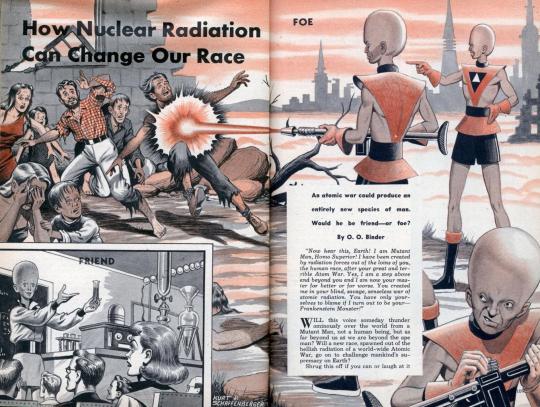
Optimistic futures were always, always vastly outnumbered by end of the world stories with mutants, Frankenstein creations that turn against us, murderous robot rebellions, terrifying alien invasions, and atomic horror. People don’t change. Then as now, we were more interested in hearing about how it could all go wrong.
To quote H.L. Gold, editor of Galaxy Science Fiction, in 1952:
“Over 90% of stories submitted to Galaxy Science Fiction still nag away at atomic, hydrogen and bacteriological war, the post atomic world, reversion to barbarism, mutant children killed because they have only ten toes and fingers instead of twelve….the temptation is strong to write, ‘look, fellers, the end isn’t here yet.’”
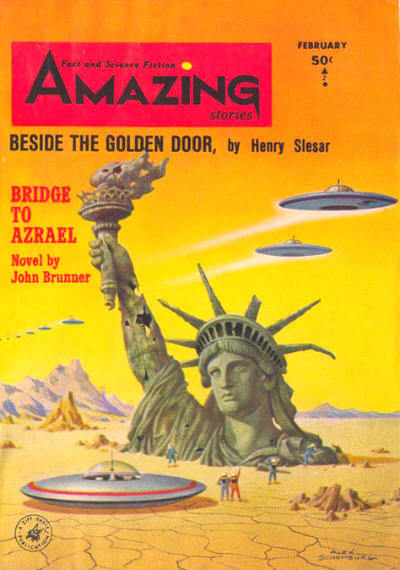
The movie Tomorrowland is a particulary egregious example of this tremendous misconception (and I can’t believe Brad Bird passed on making Force Awakens to make a movie that was 90 minutes of driving through the Florida swamps). In reality, pre-1960s scifi novels trafficked in dread, dystopian futures, and fear. There was simply never a time when optimistic scifi was overrepresented, even the boyish Jules Verne became skeptical of the possibilities of technology all the way at the turn of the century. One of the most famous pulp scifi yarns was Jack Williamson’s The Humanoids, about a race of Borg-like robots who so totally micromanage humans “for our own protection” that they leave us with nothing to do but wait “with folded hands.”
“Pulp scifi often featured muscular, large-chinned, womanizing main characters.”
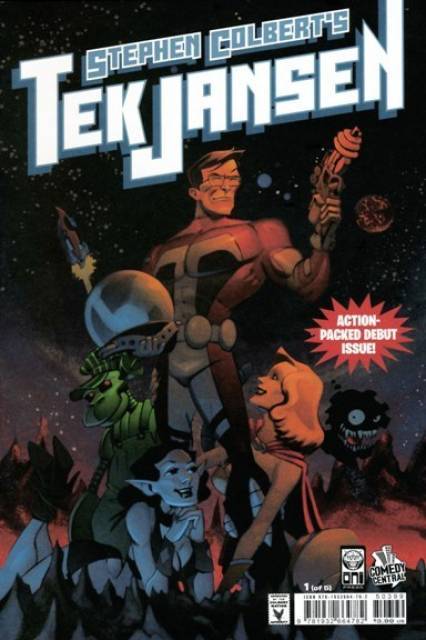
Here’s the image often used in parodies of pulp scifi: the main character is a big-chinned, ultra-muscular dope in tights who is a compulsive womanizer and talks like Adam West in Batman. Whenever I see this, I think to myself…what exactly is it they’re making fun of?
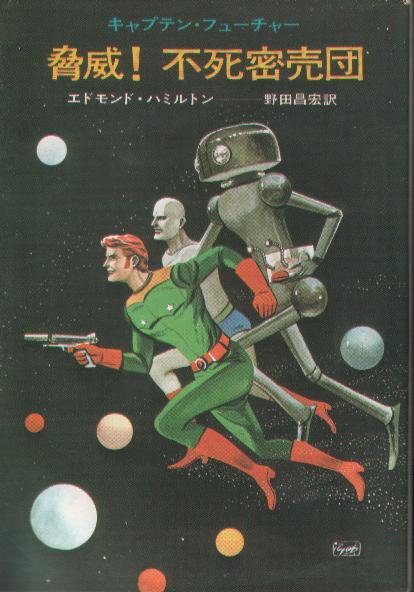
It’s more normal than you think to find parodies of things that never actually existed. Mystery buffs and historians, for example, can’t find a single straight example of “the Butler did it.” It’s a thing people think is a thing that was never a thing, and another example would be the idea of the “silent film villain” in a mustache and top hat (which there are no straight examples of, either). There are no non-parody examples of Superman changing in a phone booth; he just never did this.

In reality, my favorite description of pulp mag era science fiction heroes is that they are “wisecracking Anglo-Saxon engineers addicted to alcohol and tobacco who like nothing better than to explain things to others that they already know.” The average pulp scifi hero had speech patterns best described as “Mid-Century American Wiseass” than like Adam West or the Lone Ranger.
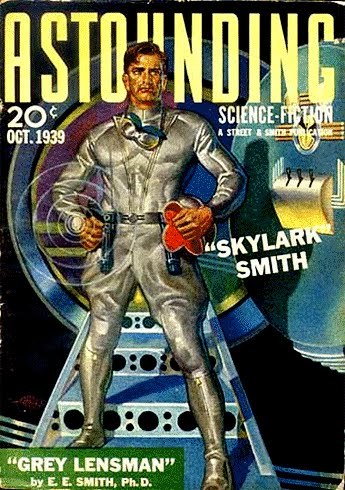
The nearest the Spaceman Spiff stereotype came to hitting the mark was with the magazine heroes of the Lensmen and Captain Future, and they’re both nowhere near close. Captain Future was a muscular hero with a chin, but he also had a Captain Picard level desire to use diplomacy first, and believed that most encounters with aliens were only hostile due to misunderstandings and lack of communication (and the story makes him right). He also didn’t seem interested in women, mostly because he had better things to do for the solar system and didn’t have the time for love. The Lensmen, on the other hand, had a ruthless, bloodthirsty streak, and were very much like the “murder machine” Brock Sampson (an attitude somewhat justified by the stakes in their struggle).
“Pulp Era Scifi were mainly action/adventure stories with good vs. evil.”
This is a half-truth, since, like so much other genre fiction, scifi has always been sugared up with fight scenes and chases. And there was a period, early in the century, when most scifi followed the Edgar Rice Burroughs model and were basically just Westerns or swashbucklers with different props, ray guns instead of six-shooters. But the key thing to remember is how weird so much of this scifi was, and that science fiction, starting in the mid-1930s, eventually became something other than just adventure stories with different trappings.
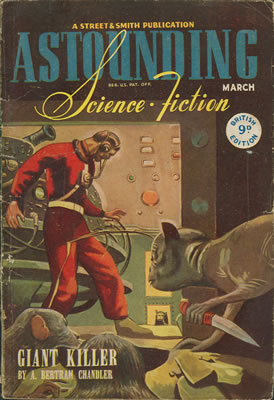
One of my favorite examples of this is A. Bertram Chandler’s story, “Giant-Killer.” The story is about rats on a starship who acquire intelligence due to proximity to the star drive’s radiation, and who set about killing the human crew one by one. Another great example is Eando Binder’s Adam Link stories, told from the point of view of a robot who is held responsible for the death of his creator.
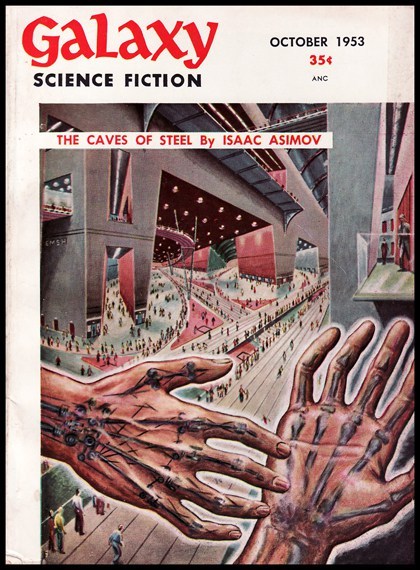
What’s more, one of the best writers to come out of this era is best known for never having truly evil bad guys: Isaac Asimov. His “Caves of Steel,” published in 1953, had no true villains. The Spacers, who we assumed were snobs, only isolated themselves because they had no immunities to the germs of earth.
“Racism was endemic to the pulps.”
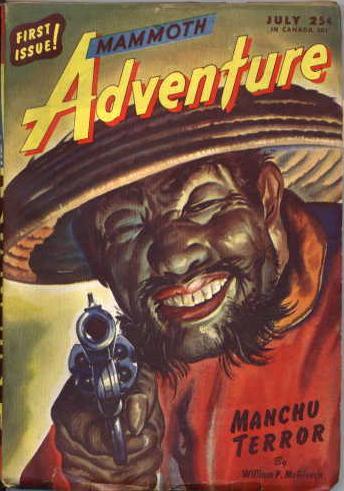
It is absolutely true that the pulps reflected the unconscious views of society as a whole at the time, but as typical of history, the reality was usually much more complex than our mental image of the era. For instance, overt racism was usually shown as villainous: in most exploration magazines like Adventure, you can typically play “spot the evil asshole we’re not supposed to like” by seeing who calls the people of India “dirty monkeys” (as in Harold Lamb).
Street & Smith, the largest of all of the pulp publishers, had a standing rule in the 1920s-1930s to never to use villains who were ethnic minorities because of the fear of spreading race hate by negative portrayals. In fact, in one known case, the villain of Resurrection Day was going to be a Japanese General, but the publisher demanded a revision and he was changed to an American criminal. Try to imagine if a modern-day TV network made a rule that minority groups were not to be depicted as gang bangers or drug dealers, for fear that this would create prejudice when people interact with minority groups in everyday life, and you can see how revolutionary this policy was. It’s a mistake to call this era very enlightened, but it’s also a mistake to say everyone born before 1970 was evil.
“Pulp scifi writers in the early days were indifferent to scientific reality and played fast and loose with science.”
FALSE.
This is, by an order of magnitude, the most false item on this list.

In fact, you might say that early science fiction fandom were obsessed with scientific accuracy to the point it was borderline anal retentive. Nearly every single one of the lettercols in Astounding Science Fiction were nitpickers fussing about scientific details. In fact, modern scifi fandom’s grudging tolerance for storytelling necessities like sound in space at the movies, or novels that use “hyperspace” are actually something of a step down from what the culture around scifi was in the 1920s-1950s. Part of it was due to the fact that organized scifi fandom came out of science clubs; Hugo Gernsback created the first scifi pulp magazine as a way to sell electronics and radio equipment to hobbyists, and the “First Fandom” of the 1930s were science enthusiasts who talked science first and the fiction that speculated about it second.

In retrospect, a lot of it was just plain obvious insecurity: in a new medium considered “kid’s stuff,” they wanted to show scifi was plausible, relevant, and something different from “fairy tales.” It’s the same insecure mentality that leads video gamers to repeatedly ask if games are art. You’ve got nothing to prove there, guys, calm down (and take it from a pulp scifi aficionado, the most interesting things are always done in the period when a medium is considered disposable trash).

One of the best examples was the famous Howard P. Lovecraft, who published “The Shadow out of Time” in the 1936 issue of Astounding. Even though it might be the only thing from that issue that is even remotely reprinted today, the letters page from this issue practically rose up in revolt against this story as not being based on accurate science. Lovecraft was never published in Astounding ever again.
If you ever wanted to find out what Star Wars would be like if they were bigger hardasses about scientific plausibility, check out E.E. Smith’s Lensman series. People expect a big, bold, brassy space opera series with heroes and villains to play fast and loose, but it was shockingly scientifically grounded.

To be fair, science fiction was not a monolith on this. One of the earliest division in science fiction was between the Astounding Science Fiction writers based in New York, who often had engineering and scientific backgrounds and had left-wing (in some cases, literally Communist) politics, and the Amazing Stories writers based in the Midwest, who were usually self taught, and had right-wing, heartland politics. Because the Midwestern writers in Amazing Stories were often self-taught, they had a huge authority problem with science and played as fast and loose as you could get. While this is true, it’s worth noting science fiction fandom absolutely turned on Amazing Stories for this, especially when the writers started dabbling with spiritualism and other weirdness like the Shaver Mystery. And to this day, it’s impossible to find many Amazing Stories tales published elsewhere.
3K notes
·
View notes